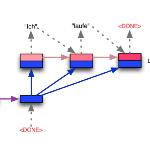Named Entity Recognition (NER) remains challenging due to the complex entities, like nested, overlapping, and discontinuous entities. Existing approaches, such as sequence-to-sequence (Seq2Seq) generation and span-based classification, have shown impressive performance on various NER subtasks, but they are difficult to scale to datasets with longer input text because of either exposure bias issue or inefficient computation. In this paper, we propose a novel Sequence-to-Forest generation paradigm, S2F-NER, which can directly extract entities in sentence via a Forest decoder that decode multiple entities in parallel rather than sequentially. Specifically, our model generate each path of each tree in forest autoregressively, where the maximum depth of each tree is three (which is the shortest feasible length for complex NER and is far smaller than the decoding length of Seq2Seq). Based on this novel paradigm, our model can elegantly mitigates the exposure bias problem and keep the simplicity of Seq2Seq. Experimental results show that our model significantly outperforms the baselines on three discontinuous NER datasets and on two nested NER datasets, especially for discontinuous entity recognition.
翻译:暂无翻译



